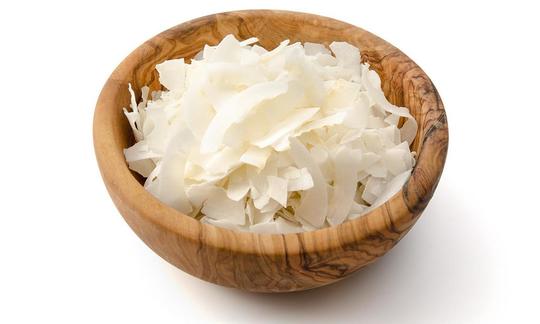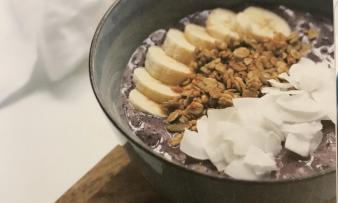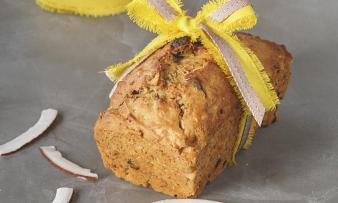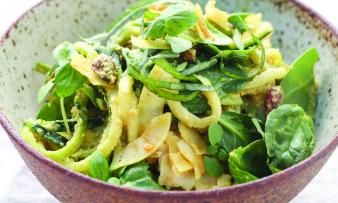Table of contents
Coconut chips (or coconut chips or coconut chips written) consist of the flesh of fresh coconuts ( Cocos nucifera).
Use in the kitchen
What are coconut chips? Coconut chips are gently dried or baked pieces of coconut flesh. They are one to several centimeters in size. They get their characteristic elongated and slightly curved shape from the natural roundness of the flesh in the coconut. Coconut chips are usually white to cream-colored. In addition to coconut chips, there are also coconut flakes, which are much smaller and higher in fat.
Coconut chips go well with sweet or savory dishes. They are usually used as a tasty snack or as a topping for your daily muesli or smoothie bowl. A few coconut chips in a fruit salad give it a light coconut flavor. They are also often used to garnish cakes, delicious desserts and sweet dishes. You can use either the chips or the coconut flakes for baking, for example for an exotic banana bread with mango and ginger. The coconut chips also go well with savory dishes such as curry butternut soup or curry bowl with pumpkin and kale.
If
How can you make your own coconut chips? you want to make your own coconut chips, cut the coconut flesh into thin strips using a vegetable peeler, cheese slicer or a sharp knife. You can season them as you like, sweet or spicy, and then roast them in the oven at 170°C for 10-12 minutes. For the raw food version, it is best to use a dehydrator and do not set the temperature above 40°C.
Vegan recipe for exotic fruit salad with coconut chips
Ingredients (for 4 people): 1 papaya, 3 green kiwis, 1/2 watermelon, juice of one lemon, 1 cm ginger, 1 handful of coconut chips, 1 bunch of peppermint.
Preparation: Halve the papaya, remove the seeds and peel. Peel the kiwi and watermelon. Cut all the fruit into bite-sized pieces. Finely grate the ginger with a hand grater. Put the fruit and ginger in a bowl and mix with lemon juice. Leave to steep for about 30 minutes. Stir again and serve in small bowls. Garnish with coconut chips and mint leaves.
Vegan recipes with coconut chips can be found under the note: " Recipes that have the most of this ingredient ".
| Not only vegans or vegetarians should read this: Vegans often eat unhealthily. Avoidable nutritional errors. |
Purchasing - Storage
Major retailers such as Coop, Migros, Rewe, Edeka, Hofer and Billa usually have coconut chips in their range all year round. Some are also organic. Volg, Spar, Aldi and Lidl occasionally have them as a special offer. Coconut chips are mostly available in organic supermarkets such as Denn's Biomarkt and Alnatura. They can also be found in Asian shops or online shops. They are mainly available pure, but occasionally sweetened, seasoned or covered in chocolate. If you value raw food quality, you should look for products that are labelled as such.
The availability of coconut chips varies depending on the size of the store, catchment area, etc. If you are interested, click on our recorded food prices for the DA-CH countries (above under the ingredient image). There you will find current prices from various supermarkets and their price development.
Storage tips
Coconut chips should be stored in a dry place and protected from heat. Unopened coconut chips will last for about two years at room temperature and opened for about one year.
Ingredients - Nutritional Values - Calories
The ingredients of coconut chips are comparable to those of coconut meat, only they are more concentrated.
Coconut chips (organic) contain 704 kcal per 100 g. They have a high fat content of 69 g/100 g. 100 g of coconut chips cover 98.1% of the daily fat requirement. They are high in fiber (14 g/100 g). The carbohydrate and protein content is low. The 24 g of carbohydrates per 100 g of chips correspond to 8.9% of the daily requirement. The protein content is 7.4 g, which corresponds to 14.8% of the daily protein requirement. 1
Coconut chips contain a significant amount of manganese. The 2.1 mg/100 g corresponds to 105% of the daily requirement of manganese. Quinoa and amaranth contain comparable amounts of manganese (2.0 mg and 2.3 mg/100 respectively), but have much less fat than coconut chips. 1
It also contains potassium, magnesium and small amounts of phosphorus and iron. 1 Since coconut chips should only be eaten in small quantities due to their high fat content, the actual nutrient content is put into perspective.
The complete ingredients of coconut chips, the coverage of the daily requirement and comparison values with other ingredients can be found in our nutrient tables. In the article Nutrients explained you will get a detailed insight into the topic.
Effects on health
Is coconut healthy? Coconut and coconut products are often praised for their high content of medium-chain fatty acids (MCT). However, this should be taken with caution. It is true that our bodies can absorb them more easily from the gastrointestinal tract into the bloodstream, which is why they are mainly used in patients with digestive and absorption disorders who suffer from energy deficiency and impaired fat absorption. But apart from that, the disadvantages clearly outweigh the advantages, especially when you consider that extra-enriched MCTs are often used for the aforementioned medical conditions and not pure coconut oil. Experts also recommend the use of MCTs only for strictly specified medical indications. 5
Can I lose weight with coconut oil? Due to the high proportion of medium-chain fatty acids (MCT), you often read that you can lose weight with coconut products. This goes back to a study by nutritionist Marie-Pierre St-Onge, who showed that medium-chain triglycerides (MCT) can help adults lose weight. 6,7,8 However, a special coconut oil was produced for this purpose that was made up of 100% of these fatty acids. Commercially available coconut oil only contains 13-14% of these medium-chain triglycerides. 7 The German Nutrition Society ( DGE) has revoked this test and trend because more recent studies have found no effect on thermogenesis or fat burning. 9
Are coconut chips healthy? Coconut products such as coconut chips consist practically only of fat. Intensive or long-term consumption in large quantities leads to long-term (and sometimes life-threatening) negative consequences. If you generally eat healthily and occasionally treat yourself to small amounts of coconut products as a special treat, this is not a problem - even if we do not recommend it.
For more information on health aspects, see the link to coconut oil (coconut oil, coconut fat).
Dangers - Intolerances - Side effects
Coconuts and coconut oil have been advertised as 'superfoods' for years. However, this is purely an industry interest in increasing sales. Vegans in particular use coconut milk as a milk or cream substitute, the oil for cooking and baking or for the skin, etc. According to interested circles, coconut blossom sugar is also said to have many advantages over conventional beet sugar.
The coconut boom is a big mistake, however, because the composition of the fatty acids in the oil is particularly unhealthy: Coconut oil consists of around 82% saturated fatty acids. At around 50%, even palm oil is healthier! Unsaturated fatty acids are also present, but the ratio of omega-6 to omega-3 fatty acids is significantly higher than the recommended maximum of 5:1 ( linoleic acid, LA, to alpha-linolenic acid, ALA).
Do coconut chips contain cholesterol? Eating coconut products increases the undesirable LDL cholesterol in the blood, which promotes cardiovascular disease. However, the healthy HDL increases slightly more, which then improves the total/HDL serum cholesterol ratio. Measured only by this ratio, coconut seems particularly healthy, which is a fallacy. In general, saturated fatty acids have a detrimental effect on blood values and cholesterol levels. A 2016 study analyzed 21 research papers, including 8 clinical studies and 13 observational studies, and concluded that replacing coconut oil with a healthier oil reduces the risk of cardiovascular disease. 4 We recommend using rapeseed oil as a substitute or replacing oil consumption with nuts and seeds if possible.
Ecological footprint - animal welfare
The ecological CO 2 footprint of coconut chips depends on various factors, including the way the coconuts are grown, processing, transport and packaging. Despite extensive research, we were unable to find any precise figures for the ecological footprint of coconut chips. According to the Big Climate Database, this is 3.5 kg CO 2 eq/kg for coconut milk 13 and 2.3 kg CO 2 eq/kg for coconut oil. 14 It can be assumed that the footprint for coconut chips is quite similar.
Due to their numerous useful properties and clever marketing, coconuts are in demand almost worldwide - as food, but also for generating energy or for making decorations, furniture or medicine. In the tropical growing countries, this creates important jobs; in the Philippines, for example, up to 3.5 million people are directly or indirectly dependent on the coconut industry. 15 However, the coconut industry should be viewed with extreme skepticism, because small farmers often manage the coconut plantations for the western market, but the price is dictated by large trading companies. The farmers can barely live on this wage. When day laborers manage company-owned plantations, the conditions there are usually inhumane. 11 Certified goods have been available for years, but have rarely been in demand. 10 It should also be remembered that coconuts have had to travel long distances for our consumption and are therefore associated with high emissions.
The area required to grow coconut palms is often associated with land grabbing, deforestation and the destruction of local biodiversity. In order to meet the high demand, mixed crops are rarely planted, but monocultures are preferred. Coconut oil is also increasingly replacing the controversial palm oil. However, the yield of oil palms, with an average of around 3.8 tons of oil per hectare, is far higher than that of coconut oil, with 0.7 tons of oil per hectare. 11 If you look at the number of endangered species per million tons of oil produced, coconut oil performs even worse than palm oil. 16
A study by the University of Exeter shows that an average of 60 species on the IUCN Red List are threatened as a result. 10 Since trained monkeys are sometimes used to harvest coconuts, consumption also leads to a lot of animal suffering. The monkeys are trained violently for several years until they are able to pick the coconuts from the tall palm trees, which they have to do while tied up until they die. 12
Worldwide occurrence - cultivation
The coconut palm ( Cocos nucifera) is the only species of this genus, but there are many different varieties. The coconut is not a nut, but a single-seeded stone fruit. It consists of three carpels that grow together, which is also why it is often slightly triangular in shape. The three eyes that you see on one side are the three germination holes, with only one germ starting to grow at a time. Coconut palms grow mainly in the equatorial zone, i.e. in tropical areas. People have been using the coconut palm for at least 3000 years. It probably originated in Polynesia (Pacific island region). From the 19th century onwards, coconuts gained economic importance when they were grown on plantations by the Dutch in Ceylon. 3
According to FAOSTAT, around 63.6 million tons of coconuts were produced worldwide in 2021. The main growing areas are Indonesia (17.1 million tons), Philippines (14.7 million tons), India (14.3 million tons), Sri Lanka (2.4 million tons). 2
For information on growing and harvesting coconuts, see Coconut meat, raw (Coconut meat, organic?)
Industrial production
When making coconut chips, the flesh of the coconut is cut into fine, thin strips. Depending on the production process, drying takes place at low temperatures of a maximum of 42 °C (raw food quality), but roasting or baking at higher temperatures are also common production methods. Some manufacturers caramelize coconut chips with coconut blossom sugar or whole cane sugar.
Further information
Coconut chips are fine, thin strips of dried coconut flesh. There are also coconut flakes, which also consist of dried coconut flesh, but which is finely grated after drying. These should not be confused with coconut flour, which is made from the pomace (pressed pulp) that remains after the production of coconut milk, coconut cream or coconut oil.
Alternative names
In English, the fruit, the tree or the seed are called coconut or cocoanut. When referring to the palm tree, one speaks of the coconut tree. In English, the product is called coco chips or coconut chips.
Coconut chips should not be confused with coconut husk chips. These are coconut fibers made from the shell of the coconut and used in the garden as a substrate or for mulching.
Bibliography - 16 Sources
| 1. | ÖNWT Die Österreichische Nährwerttabelle. Kokos Chips. |
| 2. | FAOSTAT Food and Agriculture Organization of the United Nations. Coconuts, in shell (2021). |
| 3. | Brücher H. Tropische Nutzpflanzen. Ursprung, Evolution und Domestikation. Springer: Berlin, Heidelberg, New York. 1977. |
| 4. | Eyres L, Eyres MF, Chisholm A, Brown RC. Coconut oil consumption and cardiovascular risk factors in humans. Nutr Rev. April 2016;74(4): 267–80. |
| 5. | Łoś-Rycharska E, Kieraszewicz Z, Czerwionka-Szaflarska M. Medium chain triglycerides (Mct) formulas in paediatric and allergological practice. Prz Gastroenterol. 2016;11(4) :226–31. |
| 6. | Wosen J. How coconut oil got a reputation for being healthy in the first place. STAT. Boston Globe Media. 2017. |
| 7. | St-Onge M, Ross R, Parsons W et al. Medium-Chain Triglycerides Increase Energy Expenditure and Decrease Adiposity in Overweight Men. Obesity Research. 2002;11(3). |
| 8. | St-Onge M, Bourque C, Jones P et al. Medium-versus long-chain triglycerides for 27 days increases fat oxidation and energy expenditure without resulting in changes in body composition in overweight women. International Journal of Obesity and Related Metabolic Disorders. 2003;27(1). |
| 9. | DGE Deutsche Gesellschaft für Ernährung. Mittelkettige Triglyceride für die Adipositastherapie nicht empfehlenswert. DGEinfo. 2011. |
| 10. | Meijaard E, Abrams JF, Juffe-Bignoli D, Voigt M, Sheil D. Coconut oil, conservation and the conscientious consumer. Current Biology. 6. Juli 2020;30(13):R757–8. |
| 11. | WWF-Report Speiseeis: Like Ice in the Sunshine. Kokosfett aus den Tropen - "heimischer" Raps aus Übersee. |
| 12. | PETA Missbrauch von Affen für Kokosmilch und Co. - helfen Sie jetzt! |
| 13. | CONCITO. The Big Climate Database, version 1. 2021. |
| 14. | Reinhardt G, Gärtner S, Wagner T. Ökologische Fussabdrücke von Lebensmitteln und Gerichten in Deutschland. Institut für Energie - und Umweltforschung Heidelberg. 2020. |
| 15. | Gurbuz IB, Manaros M. Impact of coconut production on the environment and the problems faced by coconut producers in Lanao del Norte Province, Philippines. Scientific Papers Series Management, Economic Engineering in Agriculture and Rural Development Vol. 19. 2019. |
| 16. | Meijaard E, Abrams JF, Juffe-Bignoli D, Voigt M, Sheil D. Coconut oil, conservation and the conscentious consumer. Current Biology Magazine. 2020. |











Comments